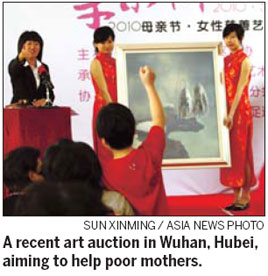No brushing aside art for charity work
Of late, one often hears of art being sold or auctioned off for charity.
The latest is nationwide efforts to help victims of drought in Southwest provinces and the earthquake in Yushu, Qinghai province.

The past two years have also seen high-brow lifestyle magazines, luxury brands, artists, collectors, entrepreneurs and charity organizations across the country, contributing their bit for relief efforts in areas devastated by the earthquake in Sichaun in 2008.
Art for charity takes many forms. Artists may create works specifically to be sold for charity or creators or owners of artistic works may donate all or part of the proceeds of the sale to a good cause. Such sales are often conducted by auction.
In Western countries, art for charity goes back to the early 20th century.
In 1933 an exhibition in New York City was held to benefit the New York City Visiting Committee of the State Charities Aid Association.
In China too, art for charity has a long tradition.
On July 2, 1879, ink painter Jin Ji published a notice in Shen Bao (Shanghai Herald) about sales of his latest works to save victims of a great famine in eastern China. His actions received warm support from the local art community.
In 1889, the Xu Yuan Artists Society was founded in Shanghai and is believed to be the first art for charity organization in modern China.
Artists have been active in disaster relief, helping school dropouts in poverty-stricken areas, and providing succor to victims of disease from low-income families.
According to an art for charity list released last week in Beijing by Forbes China and Artron Art Online, modern ink art master Xu Beihong leads the Top 25 List.
Since 1949, Xu and his family have donated 1,353 works worth 2.16 billion yuan for charity.
He is followed by Guan Shanyue, Fu Baoshi, Pan Tianshou and Li Keran.
However, not all art-for-charity endeavors have gone smoothly. Some artists and celebrities just use charity as an opportunity for self publicity.
Late last year, when a charity sale was held in Beijing to aid disabled students in Wenchuan, Sichuan province, art journalists, including me, found it disheartening that artists from some top art academies were demanding a percentage from the sale of the works. Some were also allegedly off-loading their inferior works.
Some artists speak of their unwillingness to donate or to participate in charity events, "for fear of sham charity campaigns".
Indeed, some less known organizations may well be making profits by staging art for charity events, without channeling the money to those for whom it is intended.
Legislators and law-enforcement departments must come up with measures to ratify charity organizations and regulate their conduct.
But artists should not use these factors as an excuse and stop showing generosity for people who really need a helping hand.
How much should an artist give? There is no right or wrong answer to that. It is their action and attitude toward charity that counts.
 0
0 






